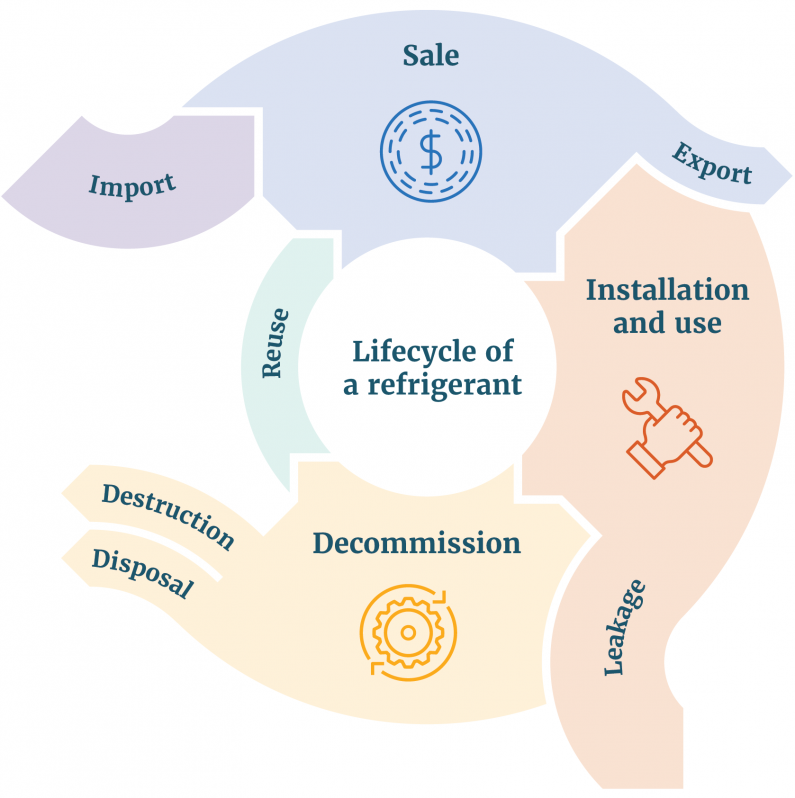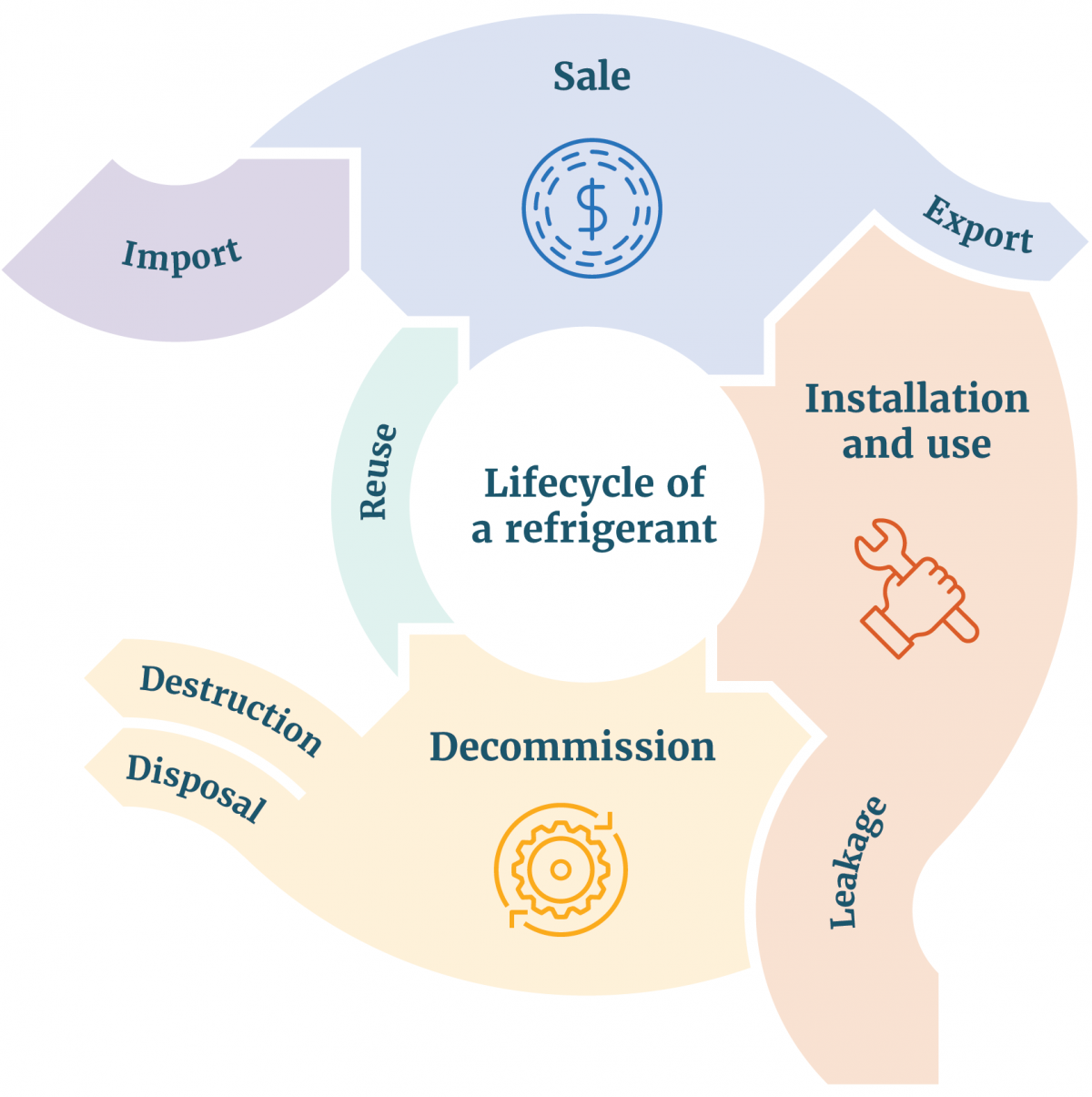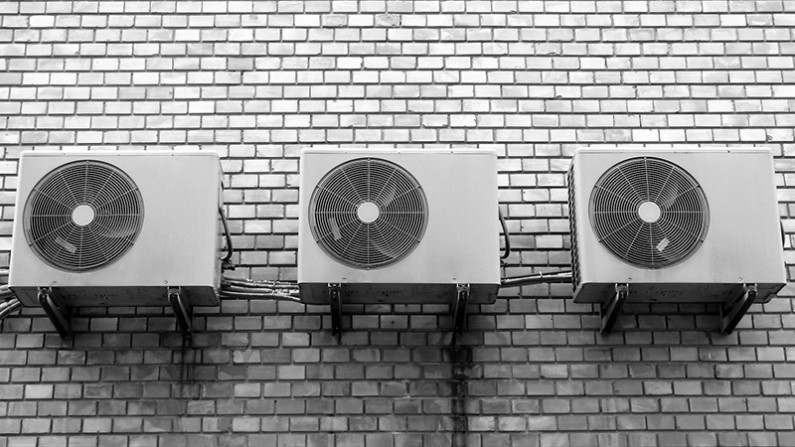Chapter 16 Fluorinated gases

Download a PDF version of this chapter [PDF, 1.2 MB]
By 2050, Aotearoa New Zealand will have transitioned away from fluorinated gases (F-gases) with high global warming potentials (GWP), while safeguarding activities that currently rely on F-gases, such as refrigeration and heating. Training and accreditation programmes will upskill the workforce and enable a safe transition to low-emissions alternatives.
|
Projected emissions without the initiatives in this plan |
7.2 Mt CO2-e |
|
Projected average annual emissions without the initiatives in this plan |
1.8 Mt CO2-e |
|
Projected percentage of total gross emissions without the initiatives in this plan |
2 per cent |
|
Estimated emissions reduction from the initiatives in this plan |
0.1 to 0.5 Mt CO2-e |
In 2019, emissions from the F-gases sector made up 2 per cent of Aotearoa New Zealand’s total gross greenhouse gas emissions.
F-gases are mainly used as refrigerants in heating and cooling appliances. Hydrofluorocarbons (HFCs) are a subset of F-gases, and HFCs are mainly used as refrigerants used in heating and cooling appliances. HFCs are believed to contribute significantly to global warming despite being emitted in relatively low quantities. This is due to their predicted impact on global warming (as indicated by their GWP).* The GWPs of F-gases can be thousands of times greater than carbon dioxide.
The Government has committed to sector sub-targets. The first sector sub-target limits F-gas emissions to 6.8 Mt CO2-e from 2022 to 2025.
* For more on global warming potential see What are ‘Global Warming Potentials’ and ‘CO2 equivalent emissions’? [NIWA website]
Moving away from F-gases with high global warming potentials will support our domestic transition to a low-emissions future and the global phase-down of F-gases agreed under the Kigali Amendment to the Montreal Protocol (Kigali Amendment).*
To achieve this transition, the Government will encourage and support New Zealanders to increasingly replace F-gases with alternatives that have lower GWPs. While some low-GWP alternatives pose risks to health and safety, the Government will promote good industry practice through training, regulated product stewardship schemes and other initiatives.
While only a small proportion of our emissions profile, F-gases have a disproportionate impact on the climate due to their GWP. In 2019, F-gases represented 2 per cent of Aotearoa New Zealand’s total emissions.
Most of Aotearoa New Zealand’s F-gas emissions are from hydrofluorocarbons (HFCs) (94 per cent), which are primarily used as refrigerants for heating and cooling. Refrigerants are an essential part of our daily life – they are used keep our food cold and used in heat pumps to heat and cool our houses. Refrigerants are also used in storage and transport of temperature-sensitive goods.*
Emissions from refrigerants do not occur as part of the day-to-day running of products such as fridges or heat pumps, as they are usually safely sealed inside the product. Rather, they typically result from leakage or improper disposal at a product’s end of life.
Product stewardship of refrigerants is important, as it will target the points in the lifecycle when F-gases are released into the environment. Expanding proposed technician training and accreditation schemes to include F-gas management will support this. The remainder of the proposals in this chapter affect the manufacture, sale and import points of the refrigerant lifecycle.
* This involves a network of refrigerated warehouses, trucks, and shipping containers known as the ‘cold chain’.


As the effects of a changing climate are felt, there will be a greater demand to artificially regulate temperatures by using refrigerants. However, increased use of high-GWP refrigerants could make matters worse and could lead to an ever-increasing need for refrigerants. Transitioning to low-GWP refrigerants is vital to avoid this cycle.

Natural refrigerants are an alternative to hydrofluorocarbon (HFC) refrigerants and have many benefits. Unlike HFCs, natural refrigerants are non-synthetic and have considerably lower global warming potentials (GWPs).
Of the range of natural refrigerants available, hydrocarbon-based refrigerants are the most viable alternative for use in air conditioning (AC). Hydrocarbons have the additional benefit of being produced from commonly used gases such as propane and butane.
Hydrocarbon-based refrigerants have also been seen to provide greater energy efficiency than HFC refrigerants, with lowering operating costs. In a Bali case study, use of non-HFC refrigerants for AC led to a fall in power consumption of around 33 per cent, with little effect on AC performance.
While hydrocarbon refrigerants have low GWPs, their use requires suitable equipment and technicians require appropriate training and skills. Improper use may result in significant risks to people and property.
A number of actions are already underway to reduce emissions from F-gases.
The Government is also working on new proposals focusing on four key areas. These proposals – outlined below – have been developed alongside principles to ensure that the transition away from high-emissions refrigerants is equitable.*
These proposals will be developed following consultation, including with Māori. This will be important in ensuring that the shift towards low-GWP refrigerants is equitable, recognises kaitiakitanga and Māori interests, and mitigates any specific impacts.
* These principles are: (a) preserving effective F-gas-reliant infrastructure (eg, the cold chain infrastructure used by the health and industrial sectors); (b) supporting access to affordable heating and cooling, particularly for low-income households; (c) maintaining health and safety standards.
The Government will continue to identify additional opportunities to reduce emissions through whole-of-life management and design options, considering ways to combine efforts to reduce HFC emissions with increasing energy efficiency, and how we can work towards a vision of low-emissions heating and cooling in Aotearoa.
Examples of approaches to improving energy efficiency, which would in turn reduce the reliance on refrigerants in Aotearoa, can be found in chapter 11: Energy and industryand chapter 12: Building and construction.
The transition away from high-GWP F-gas refrigerants will rely in part on the adoption of low-GWP refrigerants. It is important to ensure that those handling alternative gases do so in a safe manner, noting concerns about potentially increased risks presented by some alternatives (such as toxicity, flammability and high pressure systems).
These will build on existing proposals to address the increased health and safety risks associated with alternative refrigerants, and on recommendations from the final report of the Synthetic Greenhouse Gas Regulated Product Stewardship Working Group.
Further consultation will be undertaken on the proposed model before regulations are implemented. Policy outcomes are expected during the first emissions budget.
Currently, products containing high-GWP F-gases can be imported and sold in Aotearoa. In many cases, however, alternatives are available.
To address this, the Government proposes to:
Currently, refrigerant technology in Aotearoa tends to include high GWP F-gases. Servicing and maintenance requires the use of F-gases imported in bulk. Low-GWP alternatives are available, but there are several barriers, including health and safety and compatibility concerns.
To address these barriers and encourage the uptake of low-GWP refrigerants, the Government will:
Additional work and consultation will be needed to determine implementation timelines and the technical criteria for applicable refrigerants. Investigative work will be completed during the first emissions budget period.
Refrigerants have been classified as a priority product under the Waste Minimisation Act 2008. A mandatory product stewardship scheme will be developed to reduce environmental harm when they reach end of life.
The Government will:
F-gas emissions are expected to reduce, with significant reductions likely in later emissions budget periods.
It is estimated that initiatives in the F-gas sector – including the Kigali Amendment phase-down, the Synthetic Greenhouse Gas Levy, and regulated product stewardship – could reduce emissions by:
The reduction or removal impact of the three new initiatives in this chapter will support further emissions reductions; however these have not yet been quantified.
Accumulated emissions reductions are expected to continue to increase in later emissions budget periods (3.5 to 7.9 Mt CO2-e by 2050).


We need to work together to reduce high-GWP F-gases while safeguarding activities that currently rely on F-gases.
Local government can introduce initiatives that help reduce emissions from F-gases, especially in relation to inorganic collections. Incorrect disposal or kerbside scavenging of refrigerators and other equipment can result in F-gases being released into the environment. For example, Auckland Council funded community organisations to degas whiteware in the resource recovery process.
Other initiatives could include updating retrofitting homes programmes, where heat pumps are installed to help with heating and cooling, to use only low-GWP F-gases (or alternative heating options that do not rely on F-gases at all).
The private sector can help reduce F-gas refrigerants by switching to alternative refrigerants. Many large businesses that rely on cold chains and refrigerated plants to operate are leading this transition and have already made the switch. Smaller businesses also need to make the switch even though it may carry a high capital cost. The Government may need to consider support for these businesses.
As the impacts of climate change increase, there will be a growing demand for effective cooling and storage options that enable food, vaccines and vital supply chains to remain accessible and functional. It is critical that policies to reduce F-gas emissions do not have adverse effects on this infrastructure.
The best way to reduce these emissions is to phase out F-gas refrigerants and, where necessary, replace them with low-GWP refrigerants. Legislative changes may already reduce reliance on refrigerants.
For example, insulation requirements introduced by the Healthy Homes legislation are intended to result in warmer, drier homes that do not require as much artificial heating, and therefore use of refrigerants. In this way, the proposals included in this chapter build on the positive changes that are already happening in the sector.
Despite these shifts, policies in other fields will not displace the need for refrigerants entirely. It is important to signal the move away from F-gas refrigerants early and keep stakeholders informed. This will signal the transformation that will occur and reduce potential market volatility.
The proposals under consideration will also improve the ability of the heating and cooling sector to adapt by:

Chapter 16 Fluorinated gases
May 2022
© Ministry for the Environment